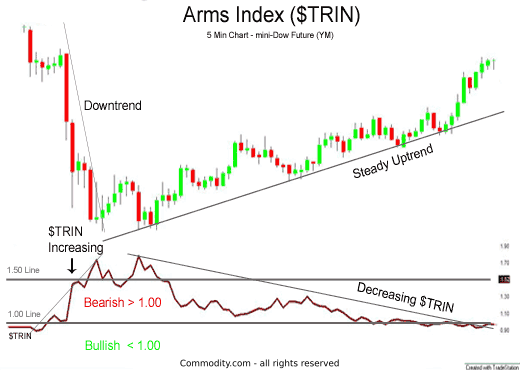Arms Index

The Arms Index is a powerful tool that offers a different perspective on market health compared to traditional technical indicators. While price-based indicators focus on individual stocks or indexes, the Arms Index analyzes the breadth of the market, considering the collective performance of all stocks. This breadth-based analysis helps traders gauge market sentiment and identify potential turning points in the market.
Understanding Market Breadth: Market breadth refers to the number of individual stocks participating in a market move. It provides a broader perspective of market sentiment beyond just the movement of a few heavily weighted stocks that can sway popular indexes like the S&P 500 or the Dow Jones Industrial Average. Market breadth indicators, like the Arms Index, consider the collective performance of all stocks to gauge market strength or weakness.
Importance of Market Internals: In times of market volatility or uncertainty, the internal dynamics of the market can diverge from the behavior of major indexes. For instance, during a market selloff, the majority of stocks may be declining even though a few high-profile stocks remain stable or show relative strength. In such situations, the Arms Index can help reveal potential market reversals by highlighting these internal imbalances.
2. Calculation of the Arms Index (TRIN):
The Arms Index, or TRIN, is derived from a simple formula that takes into account the number of advancing and declining stocks and their respective trading volumes. The formula is as follows:
TRIN = (Number of Advancing Stocks / Number of Declining Stocks) / (Up Volume / Down Volume)
Components of the TRIN Formula:
- Number of Advancing Stocks: The total number of stocks that have increased in price from the previous trading day.
- Number of Declining Stocks: The total number of stocks that have decreased in price from the previous trading day.
- Up Volume: The total volume of shares traded in advancing stocks.
- Down Volume: The total volume of shares traded in declining stocks.
Step-by-Step Calculation: Let’s understand the calculation of the Arms Index with a hypothetical example:
Suppose, on a given trading day, there are 1,200 advancing stocks, 800 declining stocks, 10 million shares traded in advancing stocks, and 15 million shares traded in declining stocks.
TRIN = (1,200 / 800) / (10,000,000 / 15,000,000)
TRIN = 1.5
In this example, the Arms Index (TRIN) is calculated to be 1.5.
3. Interpreting the Arms Index:
The Arms Index is a ratio, and its values can provide valuable insights into market sentiment. By interpreting the TRIN values, traders can identify potential market conditions and turning points.
TRIN < 1: When the Arms Index is less than 1, it suggests that the volume in advancing stocks is higher than the volume in declining stocks. This indicates buying pressure in the market and could be a bullish sign.
TRIN > 1: When the Arms Index is greater than 1, it implies that the volume in declining stocks is higher than the volume in advancing stocks. This suggests selling pressure in the market and could be a bearish sign.
TRIN = 1: When the Arms Index is equal to 1, it means that the volume in advancing stocks is equal to the volume in declining stocks. This indicates a balanced market and may not provide a clear signal.
4. Practical Applications of the Arms Index:
The Arms Index is a versatile technical indicator that can be used for various practical applications in trading.
Identifying Market Turning Points: One of the primary applications of the Arms Index is to identify potential market turning points. When the market experiences a significant move in one direction, but the Arms Index shows a divergent trend, it may signal an impending reversal. For example, in a strong uptrend, if the TRIN rises above 1, it could suggest that the buying pressure is weakening, and the market may be vulnerable to a correction.
Combining TRIN with Other Indicators: To enhance its effectiveness, traders often combine the Arms Index with other technical indicators.